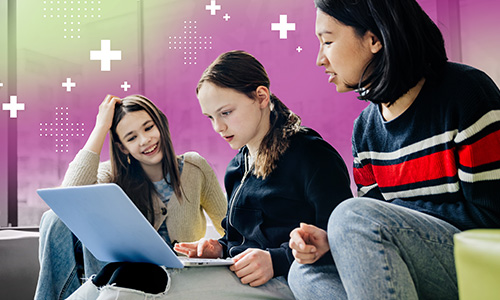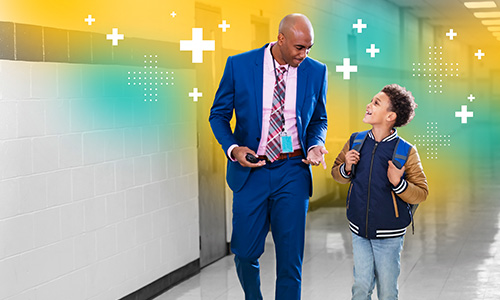Student grit, educators have been told in recent years, is a credible predictor of academic success. Perhaps in no situation has that been truer than in the midst of a pandemic. But has it not been equally true for educators?
Academic success for teachers looks different than for students, of course. Our accomplishments are measured by our students’ academic and social-emotional growth, among other things. Still, has there ever been a time when more stick-to-itiveness has been required of the professionals who educate our children? Not in my 28 years of teaching.
And yet, if COVID-19 has been the mother of all lemons, it’s still possible to make some tasty lemonade from this difficult year of teaching and learning. How ironic would it be for the very calamity that has made learning difficult for so many students to also be responsible for unleashing new approaches in education that could benefit them for years to come?
A common refrain I’ve heard among colleagues is that some changes necessitated by the pandemic are here to stay. Why? Because they are effective, that is, because they facilitate student growth and achievement. Many, but not all, are related to the technological considerations of remote teaching and learning.
Here are four things I’ll continue using long after the pandemic is over.
1. Online learning platforms
My school district uses Google Classroom. Sometimes called learning management systems (LMS), there are many tools like it to choose from, such as Seesaw, Schoology, and Blackboard. (Hardcore techies will argue about whether Google Classroom is a true LMS, but the core idea is the same: students and teachers utilize an online learning platform that delivers and organizes instruction, assessment, and communication.)
Keep in mind, I’m not new to using the internet for my students. I signed up for my first professional development about using the world wide web in teaching in the mid-1990s. I created my first teacher website in 1998 and used Moodle at various points in the 2000s.
Nothing compares to the way I use Google Classroom today. In my previous endeavors, I posted a few useful links, some handouts or video clips, and a link to my email address, but nothing as extensive as what I’ve done with Google during the pandemic. I was forced to do this on the fly when the pandemic began, of course. Yet, as the situation progressed to where we used a hybrid model and eventually returned to full in-person instruction, I’ve found the benefits to both my students and me remain consistent.
Now all my lessons, including a list of instructions, are online rather than in a lesson plan book or private document that only I see. Both the students and I can easily reference them whenever we need. Attachments, be they digital files or links to websites and video clips, are also preserved for future use. In this way, Google Classroom serves as a kind of digital binder for students. No more three-hole punching and making 150 paper copies, at least not as often. This approach also has the added benefits of saving me significant amounts of time, reducing costs for my district, and helping the environment.
Assessment of student learning is another area that has been enhanced by using an online learning platform, though not without some drawbacks. Test security is more challenging, for example, yet my ability to use data analytics is much improved; I get much more—and more useful—feedback about which questions are tripping up students and, by extension, which concepts and/or learning objectives are, too. Moreover, the use of online rubrics and comment banks has allowed me to return writing more quickly, facilitating more timely feedback.
2. Class collaboration tools
Long gone are the days of having students do fill-in-the-blank worksheets and other lower order thinking “busy work” activities, and good riddance. For years now, we’ve been having students do project-based learning (PBL) or other approaches that require them to work in groups and simulate real-world situations. But the pandemic forced educators to come up with new ways to do this in a remote environment. For instance, since we are a Google school, I use Google Meet breakout rooms for this purpose. Students are presented with an essential question or task to complete, and then they report their “solution” out to the class in the main call, where we can all reflect on what was learned together.
Of course, pre-pandemic, this type of thing was done all the time in person, and when the virus has been conquered we will do that again. There is nothing quite like face-to-face interaction, to both feed our human souls and help us work together to problem solve. But post-pandemic, I can also foresee myself having students collaborate this way outside the traditional classroom environment, enriching prosaic activities like reading an article and answering review questions by transforming it into a collaborative discussion or task. They could also collaborate on group assessments this way, when appropriate.
Again, none of this is brand-new. Microsoft Teams, Zoom, Skype, and more all existed well before March of 2020. Yet the necessity of moving to remote instruction has forced these collaboration platforms to go mainstream and encouraged educators to innovate ways of using them.
3. Publishing software for students
Also not new is digital publishing software. I remember attending a professional development training session in the mid-1990s about teaching students to use Microsoft PowerPoint. But when we moved to remote learning, having students stand up in front of the class to make a presentation was no longer possible. Teachers who wished to retain such assessments had to find new ways to do them.
In my district, the administration purchased us a district license for Book Creator, among other resources. For a recent project where students were asked to produce digital time travel brochures, many students used this and other publishing software, which I shared with the class through Google Classroom. While this was technically possible before the pandemic, I had never gotten around to it. Writ large, this historic shift we’ve all been through to remote learning has been the catalyst for change, in so many ways, if only by forcing us to finally try some of the things we’d never had time for in the past.
4. Improved structural and systemic logistics
Though structural and systemic decisions are beyond the purview of a classroom teacher like myself, I hope that some changes from the pandemic that are more about how educators collaborate, communicate, and use our time also stick around. Some of these changes were clearly overdue, but what’s the old saying? Never let a crisis go to waste! Let’s use this situation where we have had to reimagine education on the fly to reimagine what it looks like going forward.
Not all our teachers are fans of block scheduling, but our district has shifted to this structure to facilitate our hybrid platform. This has spurred serious discussion and consideration about if and how we might make this shift permanent.
When we returned to 100% in-person learning, we kept Wednesdays as a remote learning day (both synchronous and asynchronous). This has been partly to facilitate a deep cleaning of the buildings, but it is also an opportunity for teachers to check in with students and offer personal attention. Many teachers would love to see this continue after we get through this.
Our local union is also conferring with administration about keeping some other things we implemented as a reaction to the pandemic. For example, we offered phone and Zoom-style parent-teacher conferences this year, which proved to be a big hit with both families and teachers. Gone forever, we hope, are the days of parents waiting in lines outside classrooms or in cattle call–style setups in gymnasiums.
Many staff and department meetings could also be conducted this way. When being together in person is critical, we should still meet that way, of course. Just like when we teach, something significant is lost when not meeting in person. But now we can be more thoughtful about when those moments are and when a quick virtual check-in would suffice.
The need for change
I’m a high school history teacher, so the long view is in my bloodstream. And the sad fact is that American high schools, in particular, look an awful lot like they did a century ago when we experienced our last pandemic. Some of the changes we’ve implemented recently were long overdue.
Sometimes it takes a crisis to get us to reexamine fundamental issues. And guess what? That’s okay. In fact, it’s very human. But we have to possess the will to not just talk about it, but also do it. We can gripe about the lemons, or we can resolve to squeeze out that delicious lemonade. The choice is ours.









